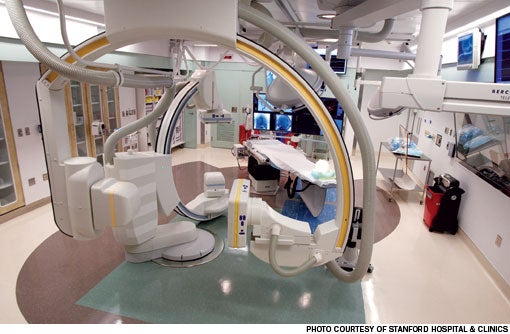New hybrid medicine room provides 'quantum leap up'
The new hybrid medicine room at Stanford (Calif.) Hospital & Clinics represents a "quantum leap up" in medical treatment. It provides many critical benefits that address patient safety as well as physician and medical staff efficiency and precision for diagnostic and OR services.
That's the glowing assessment of the hybrid room's capabilities by Robert Dodd, M.D., a neurosurgeon and interventional neuroradiologist at Stanford. He served an important role in helping to design the room, which cost about $9 million to build and equip.

The room is designed so that a patient can be diagnosed and treated with either surgery or the latest vascular interventional procedures in an environment as sterile as an OR, and that also includes the latest high-tech cath lab imaging equipment.
"What makes it hybrid is the ability to do both surgical and interventional radiology procedures, so it has the advanced imaging equipment complete with biplane imaging systems," says Shelly Reynolds, R.N., Stanford's director of cath-lab interventional services.
"It's also set up as a traditional OR suite so the patient does not need to go two places to have one complete procedure. The patient can have an entire procedure performed in one location under one general anesthesia," she says.
Under the old system a patient who had undergone surgery or a procedure and the entire medical team would move to a cath lab where doctors would verify the results of the surgery with imaging equipment and then possibly move back to the OR.
Moving the patient back and forth could take an entire day instead of only a few hours as it does in the hybrid room, says Dodd. It also eliminates the need to anesthetize a second time, says Reynolds.
The hybrid room was designed to allow collaboration between specialists in neurosurgery and neuroradiology. The centerpiece of the new space is a stereoscopic biplane digital subtraction angiography system that captures 3-D quality video images of the patient's brain. The equipment costs about $2 million, says Reynolds.
The improved detail enhances patient safety as well as diagnosis and treatment. "Combined with live fluoroscopy, the newer angiographic hardware and software in the room projects a fully dimensional image that reconstructs a patient's arterial system," says Michael Marks, M.D., chief of interventional neuroradiology. "We can understand anatomy better and navigate more precisely."
The hybrid room also features extra space to accommodate the imaging equipment as well as medical staff from the surgical team and the cath lab team at the same time, says Reynolds. The standard OR is 600 square feet, but the hybrid room is 800 square feet.




